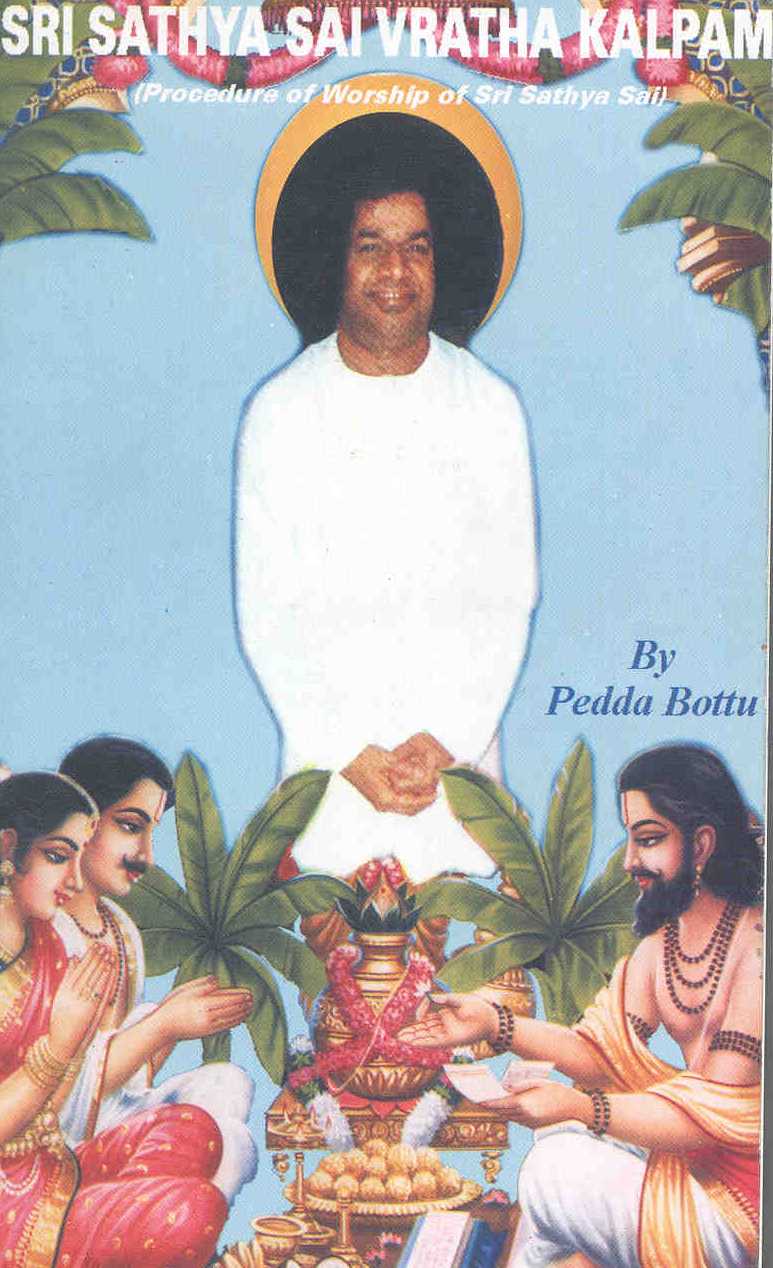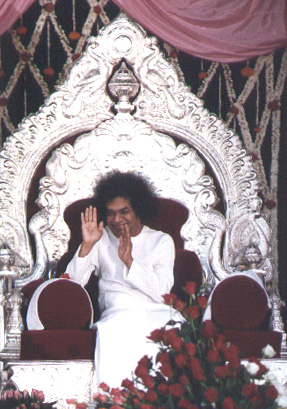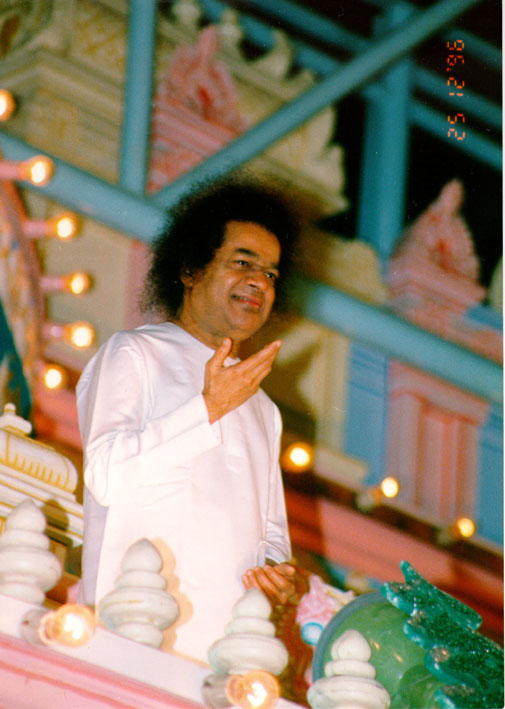



SRI SATHYA SAI VRATHA KALPAM
(Procedure of Worship of Sri Sathya Sai)
By
Pedda Bottu
Translated from Telugu by
SAI BANGARU CENTRE
JD-17/3, Gupta Colony, Khirki Extension
Malviya Nagar, New Delhi 110 017 (India)
Phone : 91-11-26674258 / 26675386
Internet and Web Designing by:
V. Krishnan
© 1998 vkram@vsnl.net
or
Phone:+919811211083
CONTENTS



Divine Message
Prayer
At the Lord's Lotus Feet
Pedda Bottu
How This Vratha Kalpam Took Shape
PART I



Dedication
A Submission
Sri Sathya Sai Vratha Kalpam
Pooja Praarambham
Atha Ganapathi Pooja
Atha Sri Sathya Sai Pooja
Dhyaanam
Atha Anga Poojaam Cha Karishye
Atha Ashtothara Pooja
Praarthana


 PART II
PART II
Sri Sathya Sai Vratha Katha
Chapter 1 Leela Kaanda
Chapter 2 Mahima Kaanda
Chapter 3 Raksha Kaanda
Chapter 4 Aadhyathmika Siksha Kaanda
Chapter 5 Bodha Kaanda
PART III
Mahaa Naivedyam
Aarathi
Swasthi
Udvaasana
Mandapa Daanam
PART IV(Annexes)
I. Purusha Sooktham
II. Manthra Pushpam
III. Guidance
DIVINE MESSAGE
- Sri Sathya Sai Baba
PRAYER
Om Sri Sai, Ganesaaya Namah
AT THE LORD'S LOTUS FEET
There are a thousand ways to hail the Glory of Sri Sathya Sai Avatar. There are songs and slokas to extol the Sai Lord of Love and Leelas. There are prayers and poojas to intone Sai Gita, invite Sai Spirit and invoke Sai Mercy.
As Sadhaks of the Sai Bangaru Centre, it is our treasured privilege to be instrumental in disseminating the Divine information on the Procedure of Worship of Sri Sathya Sai Baba, much on the lines of the age-old Sathya Narayana Vratham. A great soul and an ardent devotee of both Sri Shirdi Sai Baba and Sri Sathya Sai Baba, Srimathi G. Sarada Devi, endearingly known as "Pedda Bottu", had authored Sri Sathya Sai Vratha Kalpam containing the procedure of Pooja and five stories of Bhagavan Sri Sathya Sai Baba.
As the authoress herself mentioned, Swami desired that the whole thing should be made simple so that devotees would be able to perform it with ease.
After she completed the manuscript, she did not inform Swami about it. But to her utter surprise she found one day that it was touched up in different places by the unmistakable hand of Swami. In fact the conviction of the authoress that Swami would grant protection to those devotees who perform the Vratham was amplified by Him. He wrote that Swami would grant them fulfilment of their hearts' desires and take complete care of them at all times and with immense Love.
It is hoped that the devotees will take advantage of the holy book and perform the Pooja with pure hearts and Divine Love and be thus entitled to Swami's Grace and Protection.
We have initiated plans to translate the Vratha Kalpam into some Indian and foreign languages, besides English. We also propose to bring out audio-casettes to help the devotees to conform to the correct pronunciation of Sanskrit words.
The English translation of the holy book has been rendered smooth by the Sai Lord, His chosen instrument being a gifted writer and a Sai enthusiast-devotee, Sri M.S.B. Prasad. Sri Prasad had experienced thrills and bliss in the sadhanic role assigned to him and we in the Centre are proud of his contribution. We are most indebted to him.
Srimathi Molly Thomas has shown exemplary Sraddha (dedication) and Saburi (patience) in undertaking the computer work. We are grateful to her.
We humbly dedicate the holy book to the Lotus Feet of our beloved Bhagavan Sri Sathya Sai Baba.


 Sri Sathya Sai Vratha Kalpam is a very
Sri Sathya Sai Vratha Kalpam is a very
admirable effort and this would be a treat
for the devotees. In times to come, it would
be a Bible for the devotees for Thursdays,
especially for those who know English only.


Om Sri Sai, Brahmadevaaya Namah
Om Sri Sai, Vishnudevaaya Namah
Om Sri Sai, Maheswaraaya Namah
Om Sri Sai, Dattatreyaaya Namah
Sai Susan
Vithal Babu
New Delhi
Sri Sathya Sai Baba gave his most ardent devotee, Srimathi Gali Sarada Devi, the name of 'Pedda Bottu' as a term of endearment. It means 'Big Bindi', as she was conspicuous by the unusually large kumkum (vermilion) mark she wore on her forehead. She was born on 8.8.1888 in an extremely wealthy family of surname: Manthripragada, of Hyderabad (Andhra Pradesh). Traditionally the family were dedicated worshippers of Lord Narasimha, the man-lion avatar of Sri Mahavishnu; but they were also devotees of Sri Shirdi Sai Baba. For three generations the family had no female offspring. Soon after they obtained Sri Sai's benediction, a female baby was born; she was named Sarada Devi, after the presiding deity of Shringeri Peetham (Karnataka), as directed by Baba himself. She later changed her surname to Gali when she got married.
The baby was orphaned soon. Her mother died when she was but 9 months old; and a year later her father retired to Shringeri and embraced sannyas (renunciation). The eldest of her six paternal uncles and his wife (whom she called her father and mother) brought her up, though in that family of 150 members, to say nothing of 50 servitors, the varaprasad of Sri Shirdi Baba received love, care and attention in ample measure.
The little girl grew up in an environment of traditional learning in Sanskrit and Telugu, coupled with regular worship, purity, truthfulness and ever-pervading awareness of the proximate and strong presence of the family deity. Spiritual visions and experiences commenced even at the tender age of five.
Ever since her father had retired to Shringeri, the family was keenly desirous of inviting the Sankaracharya of Shringeri to their home but the sage was unwilling to make the journey. A yogi appeared in Sarada Devi's dream and instructed her what to do to get round the problem. He also blessed her and foretold that one day she would reach him, and that his name was Chandra Yogi.
When in due course the Sankaracharya did visit their home, the little girl was presented to him. Her respectful demeanour, intelligence and ability to answer him in Sanskrit impressed him. He observed, "This child is blessed with good bhakthi. She is destined to master six languages and to come across many yogis, saints and exalted souls in her life.Turning away from worldly concerns, she will attain salvation through worship of God's avatars". In later life, she did master six languages - Telugu, Sanskrit, Hindi, Kannada, Tamil and Marathi. Needless to add, the other predictions too proved to be equally correct.
When she was hardly six, the family made a pilgrimage to the Himalayan shrine of Badarinath. On the way, at the foot of a tree, she found a four-inch golden idol of Balagopala. That night Lord Narasimha appeared in her father's dream and directed him to initiate the child in Balagopala Manthram and worship. After two years of ritual worship, she began experiencing spiritual occurrences. A few months later she discovered her ability to write inspired poetry in Telugu as well as Sanskrit. Formal schooling stopped in her eighth year but she continued with the worship of her Gopi.
Sarada Devi was married as soon as the family returned from Badarinath; and in her twelfth year she went to live with her husband. Her parents gave her plenty of land, gold and silver befitting their high status. As her husband's people were living in a tiny village, to avoid the hardship of life there, Sarada Devi was given a big house in the nearby Rajahmundry town on the banks of the Godavari. All of them including the couple settled down in the town. But her marital life, so auspiciously begun, soon turned sour. She bore six male children in as many years but all of them died before reaching five. The husband, although a gifted musician, was a profligate. On false pretexts he cheated her of her property. To crown it all, he secretly negotiated for a second marriage. When the terrible news reached Sarada Devi's ears two or three days before the marriage day, she decided to put a bold face on it lest her parents should feel humiliated and disgraced if she publicised the tragedy. Times then were such that if a girl, though innocent, was unfairly deserted by her husband, her parental home felt besmirched. Besides, there was no divorce in those days. Poor Sarada Devi's conjugal life thus ended when she was just about eighteen. She took to wearing ochre clothes, the time-honoured garb of a sannyasini. She was penniless, homeless and husbandless - but she was rich in her bhakthi of her dear Gopi and dogged perseverance in her spiritual journey.
Intent on social service, young Sarada Devi took to teaching little school-going children. For some time she ran a music school of her own. In later years, she ran an orphanage too. She wrote several books of poetry, social dramas and songs. She was giving Harikatha performances to raise money for her orphanage. In the midst of all these activities, she was regularly visiting Shirdi. She was witness to innumerable leelas and mahimas of Sri Shirdi Sai Baba there, whom she was constantly pestering to give her some Manthram to help her in her spiritual quest. He was somehow or the other putting her off, appearing on occasions to be angry too. Sometime in 1918 an interesting event happened. One day she fell on Baba's feet begging him once again for Manthram. Apparently vexed with her insistence, he angrily turned on her kicking her in her chest. Deeply hurt, she went out, denied herself food and slept that night in the open ground under a tree. Late in the night, the ever-merciful Baba approached her and gently pacified her with soothing words. He then led her to an adjoining garden. He knew that she had no food. He stretched his right hand up and uttering "Allah Malik" (God is the Master) materialised a couple of puris and a bit of khoya to go with them. When he gave them to her to eat, she said she would go and fetch some water. He said there was no need for her to go anywhere and materialised a tiny pot of water in the same manner as he had produced food earlier. After she had her meal, in pleasing tones he spoke, "Look, my child. I will come back again in Andhra with this same name of Sai Baba. You will then come to me, enjoy my close company and attain happiness. You are well past the need for any Manthram". He added, "None of these devotees will be there to witness my second coming. Only you will do so." Soon thereafter on the Dusserah day of 1918, Sri Shirdi Sai Baba merged in the Infinite.
The news was a shattering blow to Sarada Devi who felt utterly lost. She very much needed a guru to teach and direct her towards spiritual progress. About twelve years earlier she had heard of a great Sage living somewhere in the Dwaraka hills near Ujjain Onkaara Kshethram (Madhya Pradesh). Now, in her desperate yearning, she left home and relatives behind and headed for him. After going through great privation, she succeeded in reaching him. She also found that Chandra Yogi who had appeared in her dream in her childhood and advised her about the Shringeri pontiff's visit. The Sage, who had already seventy sishyas receiving spiritual instruction from him, admitted Sarada Devi to the order. He gave her the name of Radha. In due course, she received Maha Thaaraka Manthram from the guru; she heard his daily discourses and practised spiritual disciplines and austerities and dhyan under his guidance. After six years of that blissful life, she was directed by the master to return home. She was destined, he told her, to accomplish many things in the outer world.
It was now 1940 and Sarada Devi happened to go to Uravakonda. There, in the house of a relative, she saw a youngster called Sathyam who used to come to that house often for playing. She spoke to him a little but was not particularly impressed. Later, she would recall that his hair was very kinky, that he would stand before a mirror combing it over and over again before leaving for school!
A couple of years later she met Sathyam again. This time she saw a tremendous change in him. There was around him much activity and excitement; people were flocking to him with flowers and fruits and eatables; he was encouraging them to do bhajan; if someone did a wrong thing he was openly admonishing him. He noticed her and said, "When I told you then, you did not pay heed to my word. You forgot it altogether but have again come to me now. I will proceed to Puttaparthi. Follow me there and I will tell you everything." He was just 16 years old; she was a staid fifty-four. It was now almost a quarter of a century since Shirdi Sai had foretold that he would be reborn in Andhra as Sai Baba and that he would then summon her to his presence. Could this boy, hardly out of his teens, be the Bhagavan of Shirdi re-incarnated? Should she repose complete trust in him and follow him faithfully and unquestioningly as she had done with Shirdi Baba? She was not quite sure and indecision persisted.
They met next in 1943 in Puttaparthi. In the meantime, he had revealed his avatar and came to be known as Sri Sathya Sai Baba. She was convinced by now that this was surely Sri Shirdi Baba himself re-incarnated as promised to her in 1918. She had long and close association with Sri Shirdi Baba, served him with all her heart, witnessed and also heard of his leelas and mahimas. She was his spiritual child; he used to call her affectionately "My daughter" and "My Gori (fair- skinned)." Now she was astonished to observe that Sri Sathya Sai's lips, nose, the manner in which he gesticulated and many other nuances bore an uncanny resemblance to those of the earlier avatar she had known so well. She could declare with absolute certainty that despite outward differences in their physical appearance, the innate powers (Athma Sakthis) of the two avatars were identical.
Her long search for the Master, often heart-breaking, as her poems reveal, was at last over. For a few years she visited Puttaparthi off and on. But later she made it her permanent abode - quite literally and figuratively at her Master's Lotus Feet. Soon she came to be known as Pedda Bottu. One of the special tasks she undertook was to cover and decorate with flowers the footpath leading to the bhajan venue at Prasanthi Nilayam. She would collect baskets of flowers of every hue and spread the blossoms thick on the ground in tasteful designs so that her beloved Sai Bhagavan would gracefully tread on them on his way to the venue. And, as she so fondly recorded, the soft flowers would scarcely show that they had ever been trodden upon after he walked over them!
Pedda Bottu wrote many books in prose and poetry in praise of Sri Sathya Sai Baba. She composed the present Vratha Kalpam, which was touched up by the Lord Himself in His own Divine Hand! And she also wrote her autobiography in 1984 at the ripe old age of 96 years. Simple in language but powerful in its impact on the reader, it is an extra-ordinarily compelling book - a bridge between the seen and the great unseen. It does full justice to the multi-coloured, kaleidoscopic, yet single-minded progress of Pedda Bottu's soul towards merger with Sathchidaananda Parabrahma.
Click here to go to Next part of Sri Sathya Sai Vratha Kalpam
Please contribute to International Red Cross & Red Crescent Societies by participating in their lotteries.
Sign Guestbook View Guestbook
Click here for the Previous Sai Guest Book
You are visitor number
 since JUNE 10, 1999
since JUNE 10, 1999 © 1998  vkram@yahoo.com
vkram@yahoo.com
IF PEOPLE FROM ABROAD ARE LOOKING FOR A VERY RELIABLE AND ECONOMICAL TRAVEL CO-ORDINATOR, THERE IS ONE "ERRANDS TRAVEL AND TOURS" WHO HAVE BEEN KNOWN TO ME FROM THE DAYS OF MY ASSOCIATION WITH OXFAM, UK. FOR ALL YOUR HOTEL BOOKINGS, LOCAL, AIR/RAIL TRAVELS IN ANY PART OF INDIA, CONTACT THEM THROUGH E-MAIL ADDRESS GIVEN BELOW:(MARK A COPY TO ME AT MY E-MAIL ADDRESS) THEY OFFER CUSTOMISED INDIVIDUAL AND GROUP PACKAGES AS PER SPECIFIC REQUIREMENTS AT VERY REASONABLE COST.
 errands@vsnl.comor errandstravel@hotmail.com
errands@vsnl.comor errandstravel@hotmail.com
cultLotto - Play Lotto For Free And Win Great Cash Prizes! Click Here!
Go to My
 Page |
This page hosted by
Page |
This page hosted by